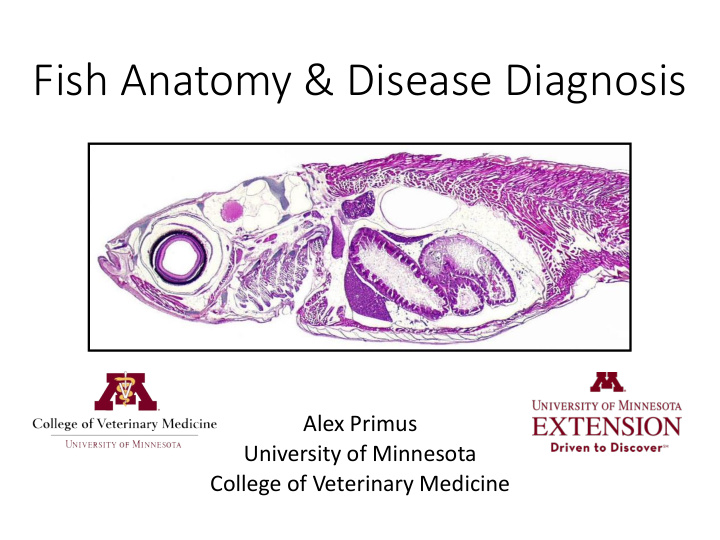



Fish Anatomy & Disease Diagnosis Alex Primus University of Minnesota College of Veterinary Medicine
Overview • Anatomy • Basic Fish Anatomy • Gills • Diagnostics • Basic • Advanced • State of the Art Dx
Why Anatomy & Diagnostics? • Anatomy • The better you know your fish – inside and out – the better you will be at recognizing disease, managing disease, and keeping your fish healthy • Recommendation: Take a good look at your fish occasionally • Get a good sense of what “normal” looks like – inside and out • Diagnostics • Some diagnostics can be done on the farm, by the producer • Help identify disease as early as possible • Best chance to manage disease early and minimize losses • Other diagnostics more complex • The more you know, the better you will be at working with your vet or diagnostic lab to manage the health of your fish
Basic Fish Anatomy
Basic Perch Anatomy - External
Perch Basic Anatomy
Perch Basic Anatomy
Fish Gills Gill Health is Extremely Important! • Involved in: • Respiration (gas exchange) • Metabolite excretion (e.g. ammonia) • Ion exchange (e.g. Na + , Cl - , etc.)
Fish Gills • Very delicate structures Normal Gill • Irritants quickly and significantly decrease function • Poor Water Quality • Ectoparasites • Bacteria • Chemicals Protist Parasite Damaged Gill
Disease Diagnosis
Diagnostic Goals • If fish are sick/dying, identify the cause of that disease • Process involves… • Identification of: • Gross morphological abnormalities • Histological abnormalities (at the level of tissues or cells) • Presence of infectious agents • Combine Dx results with clinical signs, history, WQ, etc. • Initiating factors (often poor water quality or stress) • Factors ultimately resulting in morbidity/mortality
Diagnostic Tools in Fish Health • Basic • Gross morphology • Wet-mounts (skin, fin & gill) • Advanced • Bacteriology • Virology • PCR • Histopathology • State of the Art • Electron Microscopy • Whole Genome Sequencing
Gross Morphology • External signs of Dz
Wet-Mounts • To evaluate for ectoparasites, external bacterial infections, and external fungal/saprolegina infections • Tissues/samples typically evaluated • Gill clip • Fin clip • Skin scrape
Wet-Mounts: Common Pathogens Saprolegnia Trichodina Monogenean Columnaris Flatworms
Gross Morphology • Internal signs of Dz
Bacteriology • Typically to test for systemic bacterial infections • Use swab to sample sites of interest → inoculate culture media → incubate • Ideal sites: Anterior kidney & Brain (sterile sampling) • Basic media: TSA, BHI, Blood agar • Other media required for some pathogens
Virology • Virus Isolation is the gold standard • Involves inoculating cell culture with tissues of interest • If virus present → virus infects cells → CPE • Several cell culture types & temperatures used • Sensitivity for particular virus dependent on cell type and incubation temperature • If CPE, identification of virus requires additional testing Healthy Cells CPE
Histopathology • Analysis of tissues on the microscopic level • Can be used to diagnose a number of diseases • Involves preserving tissues in fixative → embedding in solid paraffin block → slicing in very thin sections → staining sections → microscopic analysis
PCR – Polymerase Chain Reaction • Molecular assay that indicates the presence or absence of DNA specific to certain pathogens • Works by amplifying target DNA sequence if present • Quick, specific, can be very useful (particularly for viral or bacterial pathogens)
State of the Art Diagnostics Electron Microscopy Whole Genome Sequencing • Uses a beam of electrons to • Process of determining the create an image of specimen complete DNA sequence of an organism's genome at a • Much higher magnifications single time than a light microscope (Photo by A. Armien, U. of Minnesota)
Questions
Recommend
More recommend